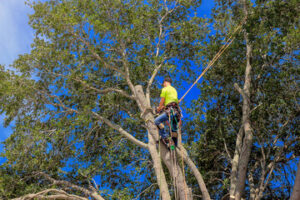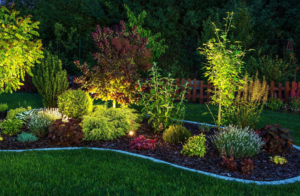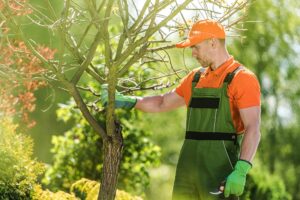Tree Service Baltimore is a way to maintain the beauty of your property while minimizing the risk of damage to your home or power lines. Professionals can spot dangerous branches that need to be removed and can prevent injuries from falling trees.

Look for insurance, licenses, and certification before hiring a tree service. Also, ask if they use spikes to climb trees while pruning and if this causes unhealthy wounds.
Trees are essential to any landscape and can enhance a home’s curb appeal. However, they can also pose a safety risk and need to be properly maintained. A professional tree service company will know how to safely and efficiently trim and prune trees and shrubs, as well as remove any dead or hazardous trees. This will ensure the health and beauty of your trees for years to come. It is important to choose a reputable tree service that has an excellent reputation. You can do this by checking online reviews and looking for a local trade association membership. You should also ask about insurance coverage and whether they have a worker’s compensation policy in case a worker gets hurt on the job site.
A reliable tree service company should offer competitive pricing for their expertise. They should also be able to accommodate your special needs and budget. They should also be able to perform a complete assessment of your property and advise you on the best course of action for your trees.
When choosing a tree service, be sure to choose one that has the right equipment for the job. They should use a crane and bucket truck to perform heavy work, such as tree removals. They should also have a 36-inch-wide and 83-foot-tall spider lift, which allows them to work on high trees without the need for a ladder. Ticos Tree Service is a Brooklyn-based company that offers a variety of tree services, including pruning, trimming, and stump grinding. The company is staffed by trained and experienced arborists, and its technicians can provide services for residential and commercial properties.
Look for signs of illness in your tree, such as fungus and flaking bark. You should also check for rot and brittle roots. These are warnings that your tree is in danger of falling. Search BBB’s list of Accredited Tree Service Companies to find an affordable and trustworthy provider.
It is a good idea to avoid hiring door-to-door contractors for projects such as tree removal. They are often scam artists that travel from town to town, preying on unsuspecting homeowners. They may also try to cut corners by using improper pruning methods. For example, they might prune your tree using climbing spikes, which are not in compliance with industry standards. If you are suspicious of a contractor’s practices, ask them to provide references from previous clients.
Insurance
There are many different types of insurance that a Tree Service should have, including general liability, workers’ compensation, commercial auto insurance and commercial property insurance. Some of these policies can be bundled together for savings in a business owner’s policy (BOP).
General liability insurance helps pay for third-party accidents that occur on the job site or when the arborist is driving to and from work sites. For example, if a client trips over an extension cord your employee left behind or a neighbor’s car is damaged by your equipment, a general liability policy would help cover any legal fees and possible settlements.
Workers’ compensation is required in most states for Tree Service companies with employees, and it covers medical expenses, rehabilitation costs and a portion of any lost wages when an employee gets injured on the job. This type of coverage is important because it ensures that a Tree Service can continue operating even if one of its employees is seriously hurt or killed while performing their job duties.
Errors and omissions insurance (E&O) is another important insurance for Tree Services, as it protects the company if a client sues the company for professional mistakes. For instance, if the company fails to properly prune or remove a tree that later falls and damages the customer’s home, E&O will pay for any legal fees and settlements.
Other insurance policies that a Tree Service should have include commercial umbrella or excess liability insurance, which adds an extra layer of protection in the event that a court decision or settlement exceeds the limits of a general liability or other insurance policy. Additionally, if you rent or borrow vehicles for your business, you should also have commercial auto insurance. This type of insurance pays to repair or replace any vehicles that are damaged or stolen.
Finally, if you have any tools or equipment that are in transit to a client’s location, you should have inland marine insurance. This type of insurance covers any damage or loss that occurs while the equipment is being transported to and from a job site.
Experience
Whether you have a large tree that needs to be removed, or you need a few shrubs pruned, you need an experienced and knowledgeable arborist. The right professional can make the difference between a job well done and one that results in damage to your property or even death. The best way to find the right tree service is to ask for references and reviews. You should also check out the company’s insurance. A legitimate company should carry personal and property damage liability as well as workers’ compensation.
A good tree service will perform pruning and trimming using the proper methods for the type of trees and their age. They will also know when to use specialized equipment. A reputable tree service will not use improper practices, such as topping or lion’s-tailing, which can kill a tree and require expensive restoration work later.
In addition to offering tree removal and pruning services, a reputable tree service will provide other important tree care services. These include stump grinding, fertilization, and tree storm repairs. Moreover, they should have experience in dealing with various kinds of trees and can help their customers choose the right trees for their needs.
When starting a tree service business, it is crucial to prepare a business plan. This should include realistic goals and first-year projections. It should also specify what your business will offer and how much it will cost. It is also a good idea to set up a separate bank account for your business so that you don’t mix your personal and business funds.
It is also a good idea to choose a name that reflects your business and is easy for potential clients to remember. This will appear on your trucks, uniforms, and documents. It should also be a word that is easily searchable online. Finally, you should consider establishing an online presence and promoting your business through social media. This will help your business grow and attract more customers.
Safety
Tree service is dangerous work, and it takes a lot of knowledge to do the job well. It’s important to hire a company that has a safety policy and follows it. Companies that invest in training and take safety seriously have fewer incidents.
One of the biggest hazards for tree workers is being struck by a falling branch. The other is getting caught in equipment or electrocuting themselves. Other dangers include slipping and falling, suffocation, and being thrown by climbing ropes or harnesses.
It’s also common for workers to get poison oak and ivy from touching the ground while trimming or pruning trees. This is why it’s important to always wear gloves and to thoroughly inspect a tree before starting any work. It’s also important to use the right safety gear, such as a hard hat and chainsaw protective clothing.
In addition to these general safety measures, it’s important to follow the specific standards set by OSHA for tree trimming. These standards are not just for compliance with federal law, but they help reduce the risk of injuries and mishaps on every job site.
For example, the Occupational Safety and Health Administration recommends that you follow a two-tree rule when felling a tree. That means you must stay a certain distance from the tree being felled to avoid being hit by limbs as they fall.
Another simple but effective safety measure is to maintain sound footing when working on slopes. You also need to ensure that all safety lines are connected and secure.
Lastly, you should read the Specification of Work report to understand exactly what you’re supposed to do. It will provide you with vital information on how to assess the tree and plan your work. This helps to eliminate mistakes and improves efficiency.
There are many different safety hazards associated with tree service, but some of them are more serious than others. In fact, some of them can be life-threatening. For example, an employee was killed when he disconnected his lanyard to move around some limbs, and then he fell off the tree.


